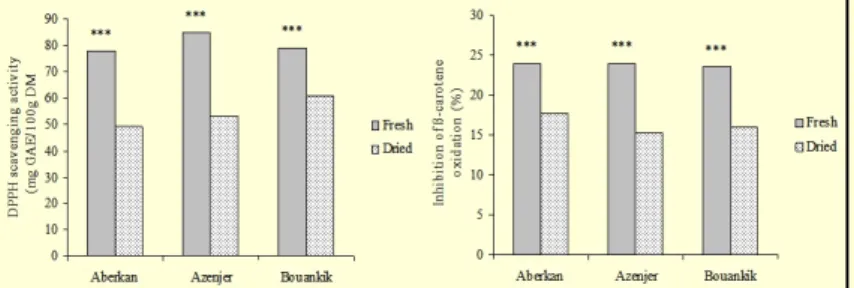Effect of sun-drying on flavonoïd composition and
antioxidant activity of three dark fig varieties
Effect of sun-drying on flavonoïd composition and
antioxidant activity of three dark fig varieties
Bachir bey M.1*, Richard G.2, Fauconnier M.L.2, Louaileche H.11Department of Food Sciences, Laboratory of Applied Biochemistry, Faculty of Nature and Life Sciences, University Abderrahmane Mira, Targa-Ouzemour, 06000 Bejaia,
Algeria. * E-mail address: bachirbeymustapha@gmail.com
2Unit of General and Organic Chemistry, Gembloux Agro-Bio Tech, University of Liège, Passage des Déportés, 2, B-5030 Gembloux, Belgium
Figs (Ficus carica L.) are native to southwest Asia and the eastern Mediterranean region, belonging to the Moraceae family. Figs are a widespread species commonly grown, especially in warm and dry climates and an important crop worldwide for fresh and dried consumption. The world production of figs was around one million tons in 2011, 70% of which was grown in the countries of the Mediterranean coast. Turkey is the world’s largest fig producer, followed by, Egypt and Algeria.
The fig is a highly perishable fruit and thus a large world production is preserved in the dried form. Fresh and dried figs are especially rich in fiber, trace minerals, antioxidant polyphenols, proteins, sugars, organic acids, and volatile compounds that provide a pleasant characteristic aroma. Fig colors vary from dark purple to green. Darker fig varieties showed higher contents of phytochemicals compared to lighter colored varieties. This elevated content in dark varieties is due to the presence of considerable rates of flavonoïds, anthocyanins particularly. Unfortunately, these substances are very sensitive to light and heat. the aim of the present study is to investigate the effect of sun-drying on flavonoïd contents and antioxidant activity of three dark fig varieties.
Sampling and sample preparation: Three fig varieties, harvested in the
region of Bejaia (North of Algeria), were used in this investigation (Aberkan, Azenjer, and Bouankik). The samples were sun dried following the traditional method and were lyophilized.
Extraction and antioxidant evaluation: Extracts were prepared according
to an already optimized protocol (Bachir bey et al., 2013). 0.2g of figs were mixed with 60% acetone/water at 40°C for 2h and three successive flavonoïds extractions were performed.
Antioxidant activity was evaluated using two methods: the DPPH radical scavenging assay, and the b-carotene-linoleic acid test.
Flavonoïds extraction and HPLC analysis: The samples were prepared
according to the method described by Escarpa and Gonzalez (1998) using 2% methanol as solvent and three consecutive extractions were performed. Extracts were analyzed by Agilent HPLC with a diode array detector at different wavelength (280, 320, 350, and 520nm). The flavonoïds were resolved using a gradient of methanol and 2% acetic acid in water. The injection amount was 10μl, the flow rate was 1 ml/min, and the column used was the column used was a Zorbax C18 (150x4.5, 3.5µm).
Table 1 shows that fresh dark fig is a good source of flavonoïds. The Azenjer variety shows the highest content with 136mg/100g MD. Rutin and cyanidin 3-rutinoside were dominant compounds. After drying the content is decreased for all flavonoïds. The anthocyanins cyanidin 3-glucoside and cyanidin 3-rutinoside were completely degraded after drying. The chromatograms acquired at 320 and 520nm clearly illustrates the degradation of flavonoïds a fter drying (Fig. 1).
As illustrated on Figure 2, the three fig varieties exhibits similar antioxydant activities (AOxA). The DPPH assay shows that sun-drying led to a AOxA decrease: AOxA diminished from 80 to 55 mg GAE/100 g MD after sun-drying. This negative effect is confirmed by the b-carotene-linoleic acid test, since about one third less of b-carotene is protected against oxidation in presence of dried fig in comparison to fresh fig.
Fig. 2. DPPH scavenging activities (left) and inhibition of β-carotene degradation (right) of dark fig varieties. *** Indicate that antioxidant activities of fresh dark fig were significantly (p<0,001) higher than dried ones.
Table 1. Flavonoid composition of dark fig varieties (mg/100g DM)
The aim of the study was to investigate the effect of sun-drying on individual flavonoïd and antioxidant activities of three dark fig varieties (Azenjar, Bouankik, and Aberkane). Flavonoïd compounds were identified and quantified using high-performance liquid chromatography. The results showed that all samples significantly differed in their flavonoïd compositions. The analyzed fig varieties contain high levels of cyanidin 3-rutinoside and rutin and appreciable content of catechin, quercetin, quercetin 3-glucoside, and cyanidin 3-glucoside. The sun-drying affect negatively all analyzed flavonoïd compounds, since their concentration is drastically decreased. Good antioxidant activities were expressed by the fig varieties before drying. The antiradical activities of fig varieties were about 80 mg gallic acid equivalent (GAE)/100g of dry material (DM) and can protect the degradation of β-carotene with 24%. After drying these activities were considerably decreased for both activities with an average of 32%. The elaboration of dried fig using sun-drying method affects dramatically the flavonoïd composition and antioxidant activity of dark fig.
Abstract
Introduction
Material and methods
Resultats and discussion
Conclusion
The sun-drying of the three dark fig varieties showed a decrease in flavonoid composition in flavonoïd compositions. These lower contents may explain the observed loss of antioxidant activities.
Acknowledgments :We thank all the laboratory staff of the Unit of General and Organic Chemistry, Gembloux Agro-Bio Tech. We thank also Ms. Beder W. for his contribution in the preparation of fig samples.
Fig. 1. HPLC-DAD chromatograms of methanol extract of Aberkan variety at 320 and 520nm. Fresh sample for blue line and dried sample for red line. Cy Glc: Cyanidin glucoside; Cy Rut: Cyanidin rutinoside; Q 3-Glc: Quercetin 3-glucoside.
